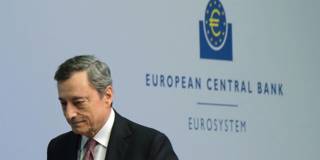To commemorate its founding 25 years ago, PS is republishing a selection of commentaries written since 1994. In the following commentary, Gita Gopinath argued that instead of asking whether the European Central Bank’s mandate allowed it to act as lender of last resort, Europe’s leaders should have been making the case for it.
CAMBRIDGE – In the summer of 2012, European Central Bank President Mario Draghi pledged to do “whatever it takes” to save the euro, including purchasing “unlimited” amounts of struggling governments’ bonds. The move, which has come to be known as the “Draghi put,” almost immediately reduced borrowing costs for Spain and Italy, and is widely touted as having pulled the eurozone back from the brink of disaster – without ever using the so-called “outright monetary transactions.”
That may sound like a resounding success: the mere announcement of the OMT scheme was enough to end the monetary union’s existential crisis. But, according to the German Constitutional Court, the policy violates European Union treaties – a ruling that the European Court of Justice is now reviewing. The ECJ’s decision will have important implications for the eurozone’s future, because it will define what authority, if any, the ECB has to intervene in a debt crisis.
And yet, in a fundamental way, the current debate about OMT misses the point. Rather than asking whether the ECB’s mandate allows it to intervene in a debt crisis, EU leaders should be asking whether it should.



CAMBRIDGE – In the summer of 2012, European Central Bank President Mario Draghi pledged to do “whatever it takes” to save the euro, including purchasing “unlimited” amounts of struggling governments’ bonds. The move, which has come to be known as the “Draghi put,” almost immediately reduced borrowing costs for Spain and Italy, and is widely touted as having pulled the eurozone back from the brink of disaster – without ever using the so-called “outright monetary transactions.”
That may sound like a resounding success: the mere announcement of the OMT scheme was enough to end the monetary union’s existential crisis. But, according to the German Constitutional Court, the policy violates European Union treaties – a ruling that the European Court of Justice is now reviewing. The ECJ’s decision will have important implications for the eurozone’s future, because it will define what authority, if any, the ECB has to intervene in a debt crisis.
And yet, in a fundamental way, the current debate about OMT misses the point. Rather than asking whether the ECB’s mandate allows it to intervene in a debt crisis, EU leaders should be asking whether it should.